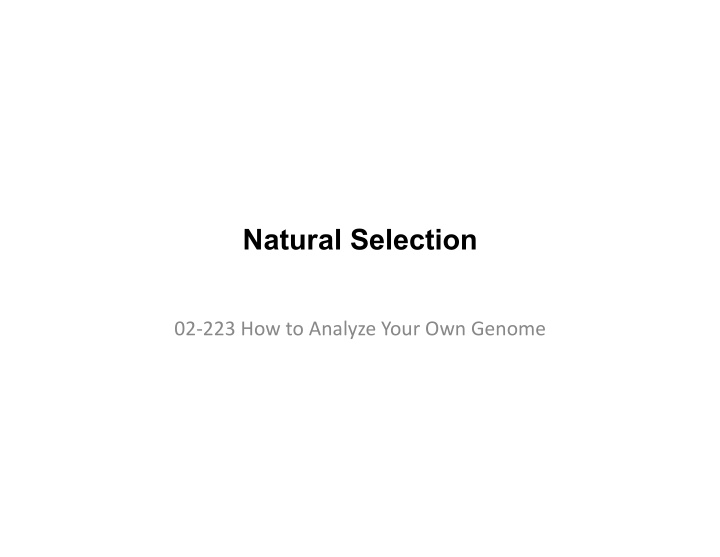



Natural Selection 02-‑223 ¡How ¡to ¡Analyze ¡Your ¡Own ¡Genome ¡
2. Reduction in Genetic Diversity (Low Diversity and Many Rare Alleles) • Gene7c ¡dri;: ¡the ¡stochas7c ¡change ¡in ¡popula7on ¡frequency ¡of ¡a ¡ muta7on ¡due ¡to ¡the ¡sampling ¡process ¡that ¡is ¡inherent ¡in ¡ reproduc7on. ¡ ¡ • Selec7ve ¡sweep: ¡The ¡process ¡by ¡which ¡new ¡favorable ¡muta7ons ¡ become ¡fixed ¡so ¡quickly ¡that ¡physically ¡linked ¡alleles ¡also ¡become ¡ either ¡fixed ¡or ¡lost ¡depending ¡on ¡the ¡phase ¡of ¡the ¡linkage ¡ • Fixa7on: ¡the ¡state ¡where ¡a ¡muta7on ¡has ¡achieved ¡a ¡frequency ¡of ¡ 100% ¡in ¡a ¡natural ¡popula7on ¡ • Hitchhiking ¡of ¡neighboring ¡neutral ¡muta7ons ¡near ¡beneficial ¡ muta7ons ¡
Selective Sweep
Selective Sweep • Selec7ve ¡sweep ¡lowers ¡the ¡gene7c ¡diversity ¡ • Subsequent ¡muta7ons ¡restores ¡gene7c ¡diversity ¡ ¡ – Rare ¡alleles ¡at ¡low ¡frequency ¡ • ~ ¡1 ¡million ¡years ¡for ¡a ¡rare ¡allele ¡to ¡dri; ¡to ¡a ¡high ¡frequency ¡ allele ¡
Complete vs Incomplete Sweep • Complete ¡sweep: ¡the ¡favored ¡allele ¡reaches ¡a ¡fixa7on ¡ – Local ¡varia7on ¡is ¡removed ¡except ¡the ¡ones ¡that ¡arise ¡by ¡muta7on ¡and ¡ recombina7on ¡during ¡the ¡selec7ve ¡sweep ¡ • Incomplete ¡sweep: ¡posi7vely ¡selected ¡alleles ¡are ¡currently ¡on ¡ the ¡rise, ¡but ¡have ¡not ¡reached ¡a ¡frequency ¡of ¡100% ¡
Low Diversity and Many Rare Alleles • Speed ¡of ¡posi7ve ¡selec7on ¡ – Rapid ¡selec7on ¡ ¡ • larger ¡selected ¡region ¡ • easier ¡detec7on ¡but ¡harder ¡to ¡dis7nguish ¡between ¡hitchhiking ¡and ¡ beneficial ¡varia7ons ¡ • Recombina7on ¡rate ¡ – Lower ¡recombina7on ¡rate ¡leads ¡to ¡a ¡larger ¡selected ¡region ¡
Low Diversity and Many Rare Alleles
3. High-frequency Derived Alleles • Derived ¡vs ¡ancestral ¡alleles ¡ – Use ¡alleles ¡in ¡closely ¡related ¡species ¡for ¡dis7nc7on ¡ • Derived ¡alleles ¡typically ¡have ¡lower ¡frequency, ¡but ¡under ¡ selec7ve ¡pressure, ¡the ¡frequency ¡rises ¡ • Many ¡high-‑frequency ¡derived ¡alleles ¡as ¡a ¡signature ¡for ¡ posi7ve ¡selec7on ¡
High-frequency Derived Alleles • Duffy ¡red ¡cell ¡an7gen ¡gene ¡in ¡Africans: ¡selec7on ¡for ¡resistance ¡ to ¡P. ¡vivax ¡malaria ¡(red: ¡derived, ¡grey: ¡ancestral) ¡
4. Population Differences • Geographically ¡separate ¡popula7ons ¡and ¡different ¡selec7ve ¡ pressure ¡on ¡different ¡popula7ons. ¡ • Rela7vely ¡large ¡differences ¡in ¡allele ¡frequencies ¡between ¡ popula7ons ¡as ¡a ¡signature ¡for ¡posi7ve ¡selec7on. ¡ • Useful ¡only ¡for ¡posi7ve ¡selec7on ¡a;er ¡popula7on ¡ differen7a7on ¡(e.g., ¡human ¡migra7on ¡out ¡of ¡Africa ¡ 50,000-‑75,000 ¡years ¡ago) ¡
Extreme Population Differences • FY*O ¡allele ¡for ¡resistance ¡to ¡P. ¡vivax ¡malaria ¡
5. Long Haplotypes • Alleles ¡under ¡recent ¡posi7ve ¡selec7on, ¡thus ¡li]le ¡break-‑downs ¡ by ¡recombina7on ¡ – long ¡haplotypes ¡with ¡high-‑frequency ¡alleles ¡ • This ¡signature ¡persists ¡for ¡a ¡short ¡period ¡of ¡7me ¡before ¡ recombina7on ¡breaks ¡down ¡the ¡chromosome. ¡
Long Haplotypes • LCT ¡allele ¡for ¡lactase ¡persistence ¡(high ¡frequency ¡~77% ¡in ¡ European ¡popula7ons ¡but ¡long ¡haplotypes) ¡
Determining Function of the Candidate Loci • What ¡is ¡the ¡associated ¡trait ¡that ¡is ¡being ¡selected, ¡given ¡the ¡ candidate ¡locus ¡for ¡selec7on? ¡ – Examine ¡the ¡annota7ons ¡of ¡the ¡genes ¡ – Look ¡for ¡associa7ons ¡to ¡phenotypes ¡in ¡a ¡popula7on ¡ – Use ¡compara7ve ¡genomics ¡ • e.g., ¡SLC24A5 ¡gene ¡posi7vely ¡selected ¡in ¡human ¡popula7on. ¡ Zebrafish ¡homolog ¡of ¡this ¡gene ¡determines ¡pigmenta7on ¡ phenotype. ¡-‑> ¡a ¡human ¡variant ¡in ¡the ¡gene ¡explains ¡roughly ¡one-‑ third ¡of ¡the ¡varia7on ¡in ¡pigmenta7on ¡between ¡Europeans ¡and ¡ West ¡Africans ¡and ¡that ¡the ¡European ¡variant ¡had ¡likely ¡been ¡a ¡ target ¡of ¡selec7on. ¡ – It ¡is ¡harder ¡to ¡iden7fy ¡func7on ¡for ¡varia7ons ¡that ¡reached ¡fixa7on ¡in ¡ human ¡popula7on ¡(i.e., ¡no ¡phenotypic ¡varia7on ¡in ¡the ¡popula7on) ¡ • e.g., ¡speech-‑related ¡genes ¡
Determining Function of Positively Selected CD36 Haplotype
Natural Selection and Diseases • Posi7ve ¡selec7on ¡ – Response ¡to ¡pathogens, ¡environmental ¡condi7ons, ¡diet. ¡ – Beneficial ¡muta7ons ¡for ¡infec7ous ¡diseases ¡can ¡be ¡selected ¡rapidly ¡ • Nega7ve ¡selec7on ¡ – Deleterious ¡muta7on ¡with ¡only ¡small ¡or ¡moderate ¡effects ¡can ¡reach ¡a ¡ low-‑level ¡frequency ¡with ¡rela7ve ¡low ¡selec7ve ¡pressure ¡
Difficulties in Detecting Natural Selection • Confounding ¡effects ¡of ¡demography ¡ – Popula7on ¡bo]leneck ¡and ¡expansion ¡can ¡leave ¡signatures ¡that ¡look ¡ like ¡a ¡posi7ve ¡selec7on ¡ • Ascertainment ¡bias ¡for ¡SNPs ¡ – Regions ¡where ¡many ¡sequences ¡were ¡used ¡for ¡ascertainment ¡may ¡ appear ¡to ¡have ¡more ¡segrega7ng ¡alleles ¡at ¡low ¡frequencies ¡with ¡more ¡ haplotypes. ¡ • Recombina7on ¡rate ¡ – Strong ¡signature ¡for ¡selec7on ¡for ¡regions ¡with ¡low ¡recombina7on ¡rates ¡
Summary • Different ¡muta7on/recombina7on ¡signatures ¡in ¡genomes ¡can ¡ be ¡used ¡to ¡detect ¡genome ¡regions ¡under ¡natural ¡selec7on ¡ – Synonymous/nonsynonymous ¡muta7ons ¡ – Low ¡gene7c ¡diversity ¡and ¡rare ¡alleles ¡ – Pronounced ¡popula7on ¡divergence ¡ • It ¡is ¡o;en ¡challenging ¡to ¡determine ¡the ¡func7onal ¡ consequence ¡of ¡the ¡naturally ¡selected ¡genome ¡region ¡
Neandertal Genome 02-‑223 ¡How ¡to ¡Analyze ¡Your ¡Own ¡Genome ¡ Fall ¡2013 ¡
Neandertals • The ¡closest ¡evolu7onary ¡rela7ves ¡of ¡present-‑day ¡humans ¡ ¡ • According ¡to ¡the ¡fossil ¡record ¡ – Neandertals ¡appeared ¡in ¡the ¡European ¡fossil ¡record ¡about ¡400,000 ¡years ¡ ago ¡ – Lived ¡in ¡large ¡parts ¡of ¡Europe ¡and ¡western ¡Asia ¡before ¡disappearing ¡ 30,000 ¡years ¡ago ¡ – During ¡the ¡later ¡part ¡of ¡their ¡history, ¡Neandertals ¡lived ¡in ¡Europe ¡and ¡ Western ¡Asia ¡as ¡far ¡east ¡as ¡Southern ¡Siberia ¡and ¡as ¡far ¡south ¡as ¡the ¡Middle ¡ East ¡ • Neandertals ¡presumably ¡came ¡into ¡contact ¡with ¡anatomically ¡ modern ¡humans ¡in ¡the ¡Middle ¡East ¡from ¡at ¡least ¡80,000 ¡years ¡ago ¡ and ¡subsequently ¡in ¡Europe ¡and ¡Asia ¡
Controversy • Did ¡Neandertals ¡interbreed ¡with ¡anatomically ¡modern ¡ humans? ¡ • if ¡ Neandertals ¡are , ¡on ¡average ¡across ¡many ¡independent ¡ regions ¡of ¡the ¡genome, ¡ more ¡closely ¡related ¡to ¡present-‑day ¡ humans ¡in ¡certain ¡parts ¡of ¡the ¡world ¡than ¡in ¡others , ¡this ¡would ¡ strongly ¡suggest ¡that ¡Neandertals ¡exchanged ¡parts ¡of ¡their ¡ genome ¡with ¡the ¡ancestors ¡of ¡these ¡groups ¡
Recommend
More recommend